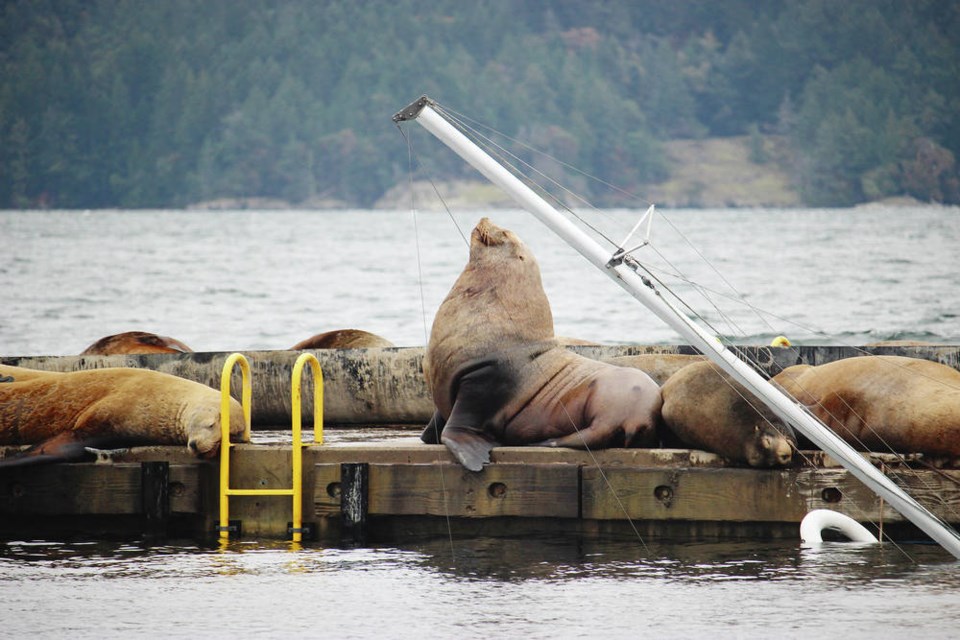While many of us are isolating as much as possible these days, a two-month-long noisy party is taking place on Cowichan Bay’s floating breakwater where massive sea lions congregate to feast on spawning salmon.
They have become a seasonal tourist attraction at picturesque Cowichan Bay, attracting a steady stream of visitors. A photo of sea lions packed on the breakwater is featured on the main page of cowichanbay.com, which promotes the region.
Steller and California sea lions jostle for space, bark 24-7, and leave stinky feces on the breakwater.
About 300 sea lions will climb onto the 182-metre-long concrete dock at one time during at the height of the season, said federal harbour manager Mark Mercer. “They are three layers deep out there.”
The majority are males, he said, likening the event to a big bachelor party. Depending on species, males range from about 850 to 2,500 pounds.
“Like I tell people: ‘What you see on the breakwater is literally the tip of the iceberg. That’s a tenth of what’s out there.’ ”
The sea lions will raft together in the waters of the bay in small groups or in numbers of 30 to 40, he said.
When room runs out on the crowded breakwater, they can spill over onto nearby moored boats. That’s what happened when a six-metre-long flat-decked sailboat was swamped Saturday morning.
The boat sank, but remains attached by rope to the breakwater. It is an abandoned vessel which had been waiting for pick-up by an agency dealing with unwanted boats.
“It’s only been in the last three years that they’ve started getting on the boats — mainly because there’s so many of them now. Every year they are a whole lot bigger and there’s a whole lot more them,” Mercer said.
They flock to the bay to catch salmon heading to rivers to spawn. Mercer said they will tear commercial fishing nets to try to reach the fish.
Rising numbers have put sea lions in the centre of a debate about whether they are harming B.C.’s wild salmon stocks.
The First Nation group Pacific Balance Marine Management has applied to Fisheries and Oceans Canada for permission to commercially harvest sea lions and seals for blubber, meat and hides.
The federal agency has not yet granted permission and requested more information.
The group maintains that the protection of seals and sea lions has led to an overpopulation of the animals, and that their appetite is hurting fish stocks.
However, Andrew Trites, director of the University of B.C.’s Marine Mammal Research Unit, said there’s not enough evidence that seals and sea lions are to blame for poor salmon stocks.
Reducing seal and sea lion numbers could impact transient killer whales, which feed on them, he said.
Canadian and international scientists are studying factors they suspect might affect salmon stocks — everything from warming ocean conditions to availability of food in the open ocean and in the case of the Fraser River, a massive landslide blocking salmon trying to reach their home streams. Major federal efforts have been made to clear out fallen boulders and to create fish ways to allow salmon to spawn. Some groups blame sea lice and fish farms for declining salmon numbers.
Meanwhile, day-to-day life in Cowichan Bay means getting used to the sea lions.
“I have to keep all my windows and my doors closed between the noise and the stink,” Mercer said.
The sound of their round-the-clock barking bounces off the walls of an adjacent hotel and into his office, he said.
“They are very vocal, actually.”
One will start barking and set others off.
As for the odour, on windless days when Mercer is outdoors checking on boats, “I’ll tell you my eyes are watering from the ammonia. You can barely breathe down there.”
Their feces stinks of “rotten fish,” he said.
So far the sea lions have stayed away from the bay’s main docks. The breakwater is not accessible to visitors. Although Mercer has not seen any of the sea lions behave aggressively to anyone, it is best to keep them apart.
Despite their huge size, sea lions are fast and agile, he said. They are easily able to jump a few feet out of the water to get onto the breakwater.
Seagulls watch what the sea lions are up to. Mercer recently watched the birds flock to a sea lion which was catching salmon in the water and slapping the bodies on the dock — sending a spray of orange-coloured fish roe into the air. Both the birds and sea lions love the roe, he said.
— with file from Roxanne Egan-Elliott



